Toyota RAV4 (XA40) 2013-2018 Service Manual: Underdrive clutch
Components
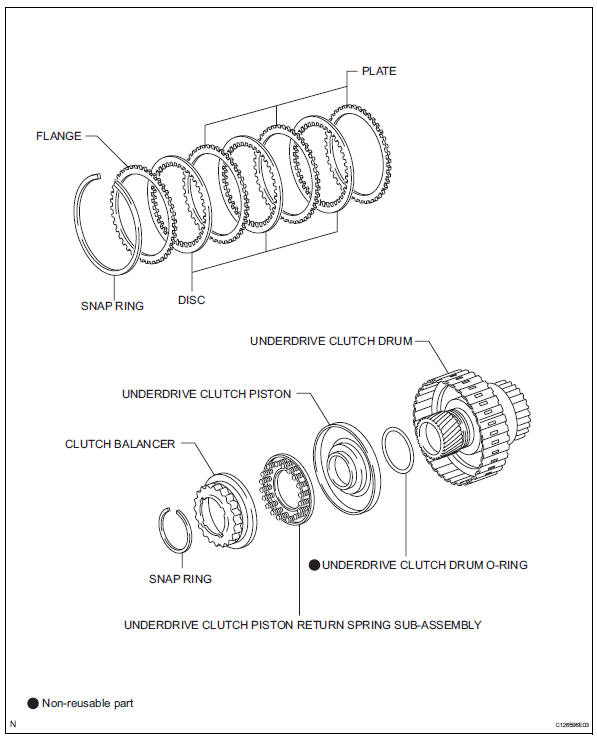
Disassembly
- Inspect pack clearance of underdrive clutch (see page ax-247)
- Remove no. 1 Underdrive clutch disc
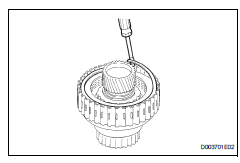
- Using a screwdriver, pry out the underdrive clutch flange snap ring.
- Remove the flange, 3 discs and 3 plates from the underdrive clutch drum.
- Inspect no. 1 Underdrive clutch disc (see page ax-248)
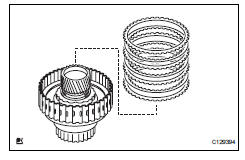
- Inspect underdrive clutch drum subassembly (see page ax-248)
- Remove underdrive clutch drum o-ring
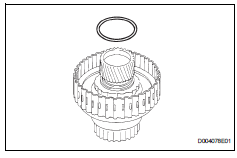
- Remove underdrive clutch piston set
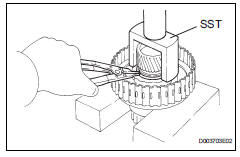
- Place sst on the clutch balancer and compress the spring with a press.
Sst 09350-32014 (09351-32070)
- Using a snap ring expander, remove the snap ring.
Notice:
- Stop the press when the spring sheet is lowered to a position 1 to 2 mm (0.04 To 0.08 In.) From the snap ring groove.
- This prevents the spring sheet from being deformed.
- Do not expand the snap ring excessively.
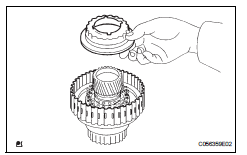
- Remove the clutch balancer from the underdrive clutch drum.
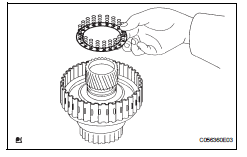
- Remove the piston return spring from the underdrive clutch drum.
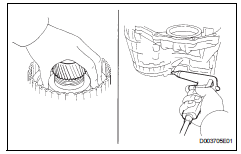
- Install the underdrive clutch to the transaxle.
Notice:
Be careful not to damage the oil seal rings.
- Holding the underdrive clutch piston with your hand, apply compressed air (392 kpa, 4.0 Kgf/cm2, 57 psi) to the transaxle case to remove the underdrive clutch piston.
- Inspect underdrive clutch return spring sub-assembly (see page ax-248)
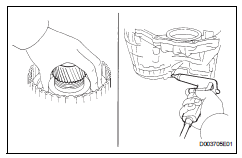
Inspection
- Inspect underdrive clutch pack clearance
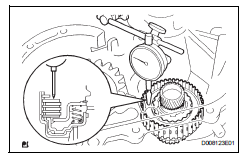
- Install the underdrive clutch to the transaxle.
Notice:
Be careful not to damage the oil seal rings.
- Install a dial indicator as shown in the illustration.
- Measure the underdrive clutch pack clearance while applying and releasing compressed air (392 kpa, 4.0Kgf/cm2, 57 psi)
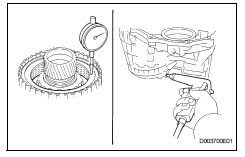
Standard pack clearance: 1.51 To 1.90 Mm (0.0594 To 0.0748 In.)
If the pack clearance is not as specified, inspect the discs, plates and flange.
- Inspect no. 1 Underdrive clutch disc
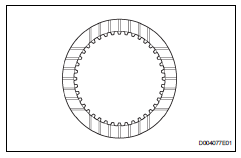
- Check to see if the sliding surface of the disc, plate and flange are worn or burnt. If necessary, replace them.
Hint:
- If the lining of the discs is peeling off or discolored, or even if a part of the printed mark is defaced, replace all discs.
- Before assembling new discs, soak them in atf for at least 15 minutes.
- Inspect underdrive clutch drum subassembly
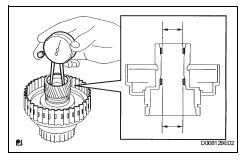
- Using a caliper gauge measure the inside diameter of the underdrive clutch drum bush.
Standard drum bush: 37.06 To 37.08 Mm (1.4591 To 1.4598 In.)
Maximum drum bush: 37.13 Mm (1.4618 In.)
If the inside diameter is greater then the maximum, replace the underdrive clutch drum sub-assembly.
- Inspect underdrive clutch return spring sub-assembly
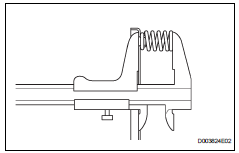
- Using a vernier caliper, measure the free length of the spring together with the spring seat.
Standard free length: 17.14 Mm (0.6752 In.)
Installation
- Install underdrive clutch piston set
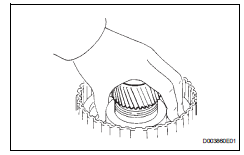
- Coat the underdrive clutch piston with atf, and install it to the underdrive clutch piston drum.
Notice:
Be careful not to damage the o-ring.
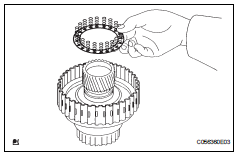
- Install the piston return spring to the underdrive clutch drum.
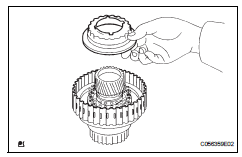
- Install the clutch balancer to the underdrive clutch drum.
Notice:
Be careful not to damage the lip seal of the clutch balancer.
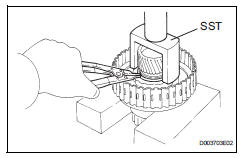
- Place sst on the clutch balancer and compress the piston return spring with a press.
Sst 09350-32014 (09351-32070)
- Using a snap ring expander, install the snap ring to the underdrive clutch drum.
Notice:
- Be sure the end gap of the snap ring is not aligned with the clutch balancer's claw.
- Stop the press when the spring sheet is lowered to a position 1 to 2 mm (0.039 0.078 In.) From the snap ring groove.
- This prevents the spring sheet from being deformed.
- Do not expand the snap ring excessively.
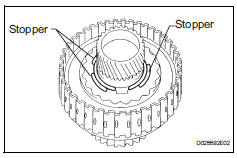
- Set the end gap of the snap ring in the underdrive clutch drum shown in the illustration.
Notice:
The end gap of the snap ring should not coincide with any of the stopper.
- Install underdrive clutch drum o-ring
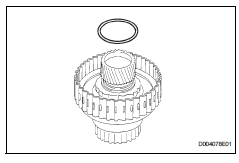
- Coat the new o-ring with atf, and install it to the underdrive clutch drum.
- Install no. 1 Underdrive clutch disc
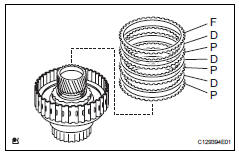
- Install the 3 plates, 3 discs and flange to the underdrive clutch drum.
Install in order: p - d - p - d - p - d - f
Hint:
P = plate
D = disc
F = flange
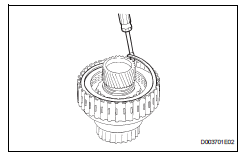
- Using a screwdriver, install the underdrive clutch flange hole snap ring.
- Check that the end gap of the snap ring is not aligned with one of the cutouts.
- Inspect underdrive clutch pack clearance
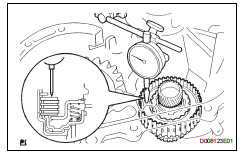
- Install the underdrive clutch to the transaxle.
Notice:
Be careful not to damage the oil seal rings.
- Set a dial indicator as shown in the illustration.
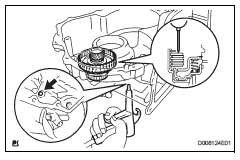
- Measure the underdrive clutch piston stroke while applying and releasing compressed air (392 kpa, 4.0 Kgf/cm2, 57 psi).
Standard pack clearance: 1.51 To 1.90 Mm (0.0594 To 0.0748 In.)
If the pack clearance is less than the minimum, parts may have been assembled incorrectly, so check and reassemble again.
If the park clearance is not as specified, select another flange.
Hint:
There are 3 flanges in different thickness.
Standard flange thickness

 Underdrive planetary gear
Underdrive planetary gear
Components
Disassembly
Remove underdrive planetary gear
preload (see page ax-240)
Remove underdrive input shaft nut
Sst 09930-00010 (09931-00010, 09931-00020),
09387-00050, 09564-1602 ...
 Valve body
Valve body
Components
Disassembly
Remove shift solenoid valve slt
Remove the bolt, plate and shift solenoid valve slt
from the valve body.
Remove shift solenoid valve sl1
Rem ...
Other materials:
Sun visors and vanity
mirrors
Sun visors
Forward position:
flip down.
Side position:
flip down, unhook, and swing
to the side.
Side extender (if equipped):
place in side position then slide
backwards.
Vanity mirrors
Slide the cover to open.
The light turns on when the cover
is opened.
Notice
To ...
Do-it-yourself service
precautions
If you perform maintenance by yourself, be sure to follow the
correct procedure as given in these sections.
Caution
The engine compartment contains many mechanisms and fluids that may
move suddenly, become hot, or become electrically energized. To avoid death
or serious injury, obse ...
Evaporative emission control system pressure sensor
Dtc summary
Hint:
The canister pressure sensor is built into the canister pump module.
Description
The description can be found in the evap (evaporative emission) system (see
page es-335).
Monitor description
Dtc p0450: canister pressure sensor abnormal fluctuation
If t ...
